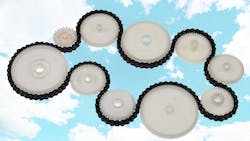This article was updated May 12, 2023. It was originally published Feb. 1, 2000.
Chain drives traditionally handled heavy loads in harsh conditions, and many still do. But although they started out as all-metal assemblies to put up with the Herculean demands, today, many chain-drive sprockets are made of plastic.
In fact, there are now a host of plastics readily available that offer engineers material properties that metals can’t when it comes to sprockets. (Just to be clear, sprockets are the round, toothed components that transmit and receive power in chain drives. They mesh with the chain; there is no tooth-to-tooth contact as there is with sprockets.)
READ MORE: Plastic Bearings: The Pros and Cons
Engineers opt for plastic sprockets because they resist corrosion and chemicals, put less wear-and-tear on chains, and never suffer static or electrical-charge problems. They also require no lubrication, which means no toxic lubricants. They also bring some positive attributes.
Plastic sprockets can be lightweight with low coefficients of friction, which makes them quieter and more efficient. And the USDA and FDA have already approved many of them.
Plastic Benefits
Many types of polymers are used to make sprockets, so engineers should know how each performs under various conditions to get the best one for their specific application. Here are the some of the plastics commonly used:
Acetal is a good choice if the application requires close-toleranced sprockets. It machines well, is easily injected molded, and has a low coefficient of friction. It is hard and resists creep but tends to be brittle and only moderately resists abrasion. It is often used to make small roller chain or custom sprockets.
Glass-filled nylon contains glass fibers, usually added during injection molding, to increase its rigidity for high-load applications. Sprockets made from it usually have some porosity, which makes them weaker compared to those machined from cast nylon. Sprockets used with roller chains are good candidates for glass-filled nylon.
Oil-filled nylon resists impacts, abrasions, and chemicals. It is a rigid material and resists creep and distortion of keyways, the components that attach sprockets to shafts. This type of nylon is used to make both roller and flat-top chains.
READ MORE: Planetary Gears: The Basics
Polypropylene offers a good balance of thermal, chemical and electrical properties. It also has a low coefficient of friction, plus fair impact and abrasion resistance. Polypropylene sprockets are typically used in chemically harsh environments because they resist attack by most organic chemicals, mineral acids and gases.
PTFE (Polytetrafluoroethylene), also called teflon, has a very low coefficient of friction and can withstand a wide range of temperature ranges. It resists impacts, abrasion, and chemicals. But it is relatively expensive and therefore seldomly used for sprockets.
Polyurethane can be made hard for sprockets so that it is rigid and resists creep. It resists abrasions well but tends to have a high coefficient of friction and poor impact resistance. Engineers choose it because it is easily injection molded, a major advantage for mas-produced parts. Polyurethane sprockets are typically found in the milling and wastewater industries.
UHMW-PE (ultra-high-molecular weight polyethylene) has a low coefficient of friction and high impact strength. The USDA/FDA-approved plastic also resists chemicals and abrasion. This material is well-suited for moderate-load applications.
Important criteria in selecting a plastic for sprockets include the expected loads and torques it can be expected to see. And do they fluctuate wildly? How often will the chain drive start and stop, and will it change directions?
READ MORE: Lubricating Plastic Gears and Bearings
If the potential loads are too high for a conventional plastic sprocket, it can be modified to increase its load capacity. For example, metallic hubs are often bolted to large sprockets such as those used with sidebar chains in mills and combination chains in agricultural applications. The hub distributes loads over a larger area/volume of plastic to lower local stresses and increase load capacities.
For smaller drive components, such as roller chain sprockets or timing belt pulleys, a hexagonal metal insert spreads the load. In a recent test, plastic sprockets with metal inserts exceeded the load capacity of conventional plastic sprockets by a factor of three. These metal inserts are often used in food-processing and packaging industries because they trap fewer food particles and are easier to keep clean than bolt-on hubs.
Plastics in Action
Plastic sprockets let companies in a variety of industries improve and streamline their processes. For example, a company was having problems with the conveyors they made. Chicken and meat on those conveyors could be cut into desired portions using computer-controlled, high-pressure water jets.
The company’s engineers specified that all the chain drives on the conveyor be nickel-plated to withstand repeated washdowns. But the plating did not hold up. It flaked off, which let the underlying metal corrode while the flakes contaminated the food being processed, according to the production manager.
READ MORE: A Gallery of Basic Gears
To eliminate the problem, the company switched over to UHMW-PE sprockets. They proved to be cost effective and have good wear characteristics, according to the manager. Plus, they met USDA/FDA requirements for food processing plants.
Another company, this one making equipment for the lumber industry, developed an infeed table that sends 20 pieces of lumber per minute into an edger equipped with several saw blades. In the design phase for this device, the firm’s engineers chose a plastic for the idler drive sprockets. The choice was in part spurred on by many of the company’s customers asking for plastic sprockets to lower the noise and extend the chain’s life.
The resulting sprockets were made of UHMW-PE and are much lighter—a sound engineering reason to use them, since the table moves up and down continuously. The lightweight sprockets also reduce wear-and-tear on the feeder and let the table operate more efficiently, according to the project’s design engineer.
Stan Heister was a product manager at Solidur Pacific Co. when this article was originally published.
